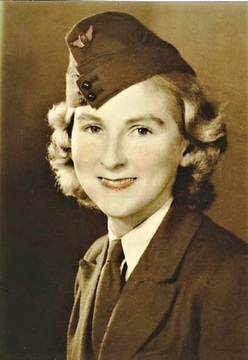RANNARD, Jean Elizabeth
| Other Name: | PEARCE, Jean Elizabeth - Married Name |
|---|---|
| Service Numbers: | N281012, NX77202 |
| Enlisted: | 3 October 1941 |
| Last Rank: | Private |
| Last Unit: | Australian Army Medical Women's Service |
| Born: | Parramatta, New South Wales, Australia, 6 September 1918 |
| Home Town: | Sydney, City of Sydney, New South Wales |
| Schooling: | Merrylands public school; Paramatta Domestic Science School; Granville Technical College New South Wales Australia |
| Occupation: | Dressmaker |
| Died: | Natural causes, Queen Victoria Home, Lindisfarne, Tasmania, Australia, 7 September 2008, aged 90 years |
| Cemetery: |
Cornelian Bay Cemetery and Crematorium, Tasmania Cremated - ashes interred in Pearce-Bendall Family Vault |
| Memorials: |
World War 2 Service
| 3 Oct 1941: | Enlisted Australian Army (Post WW2), Private, N281012 | |
|---|---|---|
| 4 Dec 1941: | Enlisted Australian Military Forces (WW2) , Private, NX77202 | |
| 4 Dec 1941: | Discharged Australian Army (Post WW2), Private, General Hospitals - WW2 | |
| 4 Dec 1941: | Enlisted Private, NX77202, Australian Army Medical Women's Service | |
| 22 May 1945: | Discharged Australian Military Forces (WW2) , Private, NX77202 | |
| 22 May 1945: | Discharged Private, NX77202, Australian Army Medical Women's Service |
Help us honour Jean Elizabeth RANNARD's service by contributing information, stories, and images so that they can be preserved for future generations.
Add my storyBiography contributed by VWM Australia
Biography and all family images courtesy of Annette Macquarie (nee Pearce) (daughter) and Graham Pearce (son)
Jean Elizabeth Rannard was born at Merrylands, New South Wales, in 1918 where her parents ran a large poultry farm. She attended the local Merrylands public school, then Paramatta Domestic Science School and finally Granville Technical College to continue with dress designing after her mother’s death. She served an apprenticeship with Grace Brothers where she was working when war broke out. She enjoyed tennis and tapdancing.
She wanted to help out with the War and decided the best way was to join the Voluntary Aid Detachment. Jean did her 60hrs voluntary work at Ryde Hospital during weekends and then gave up her dressmaking job and went to Sydney Hospital as a voluntary worker. On 3 Oct 1941 she was called up for 113th Australian General Military Hospital Concord Sydney joining the Army (later called Australian Army Medical Women’s Services A.A.M.W.S.) as a Voluntary Aide
Jean was set to go to the East but Japan entered the war and they were sent back to the Concord Hospital.
On 27 Jan 1942 she sailed on the 1st Netherlands Military Hospital Ship ‘Oranje’ lent for the duration of the War and carrying an equal complement of Dutch, New Zealand and Australian staff. The 15 Australian V.A.Ds onboard were under Matron Jewell.
They travelled via Simonstown (Cape Town) , Durban and Aden to Tewfik (Suez) where they collected patients and returned to Australia disembarking at Adelaide and Sydney. They later found out that Japanese submarines had come through the submarine nets at Sydney Heads when they were opened for the departing ‘Oranje’, and caused substantial damage. The remainder of their patients were disembarked at Wellington where the ship and crew stayed for 2 weeks as guests of the New Zealand government.
Another trip was made to the Middle East where they collected English patients (mainly bad bed patients ex El Alamein) from Tewfik and took them to Durban then back to Tewfik to collect Australians and New Zealanders. They were diverted to New Zealand for security reasons as the 9th Division hadn’t arrived.
The ’Oranje’ remained anchored midstream in Wellington for 2 weeks then returned to disembark the Australian patients. About 4 Mar 1943 the ‘Oranje’ was handed over to England and headed back to the Middle East. Matron Jewell, the sisters and orderlies all transferred to the ’Centaur’ which was later torpedoed by a Japanese submarine off the Brisbane coast on 14 May 1943 and only 64 of the 322 persons on board survived: Sister Ellen Savage was the only one of the 12 Army Nurses to survive.
Jean was transferred to Goulburn Camp , then on 22 Apr 1943 to 2 Australian Army Medical Women’s Service Training Company at Bathurst where she had to treat tent-housed patients with malaria in winter (Jean’s son, Graham, has had malaria, been overnight in Bathurst in winter and slept in tents, but not at the same time. Graham understands why in later years his mother considered this one of her worst memories of the War). On 26 Jul 1943 Jean was transferred to 2/6th Australian General Hospital at Rocky Creek on the Atherton Tablelands, Qld, where the daily bed average had increased to 1760. It was there she met her future husband Lindsay Pearce.
The camps were all under canvas with dirt floors and their patients were from New Guinea, the Islands and the Middle East as well as casualties from troops in training (accidents). The hospitals were full and there were quite a few cases of malaria.
Jean Rannard and Lindsay Pearce married on 26 Jan 1945 at Innisfail. On 22 May 1945, Jean, being 4 months pregnant, was discharged from the Army and went to her family in Sydney before making her home with Lindsay in Tasmania after the War finished, where they had 4 children, living at New Town and then Lindisfarne.


















